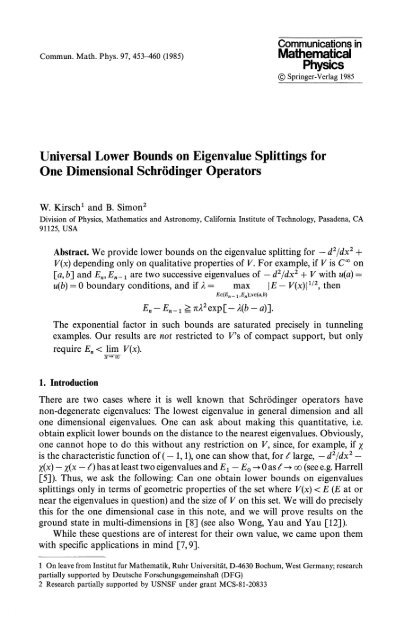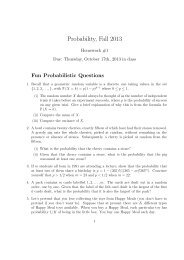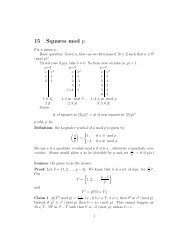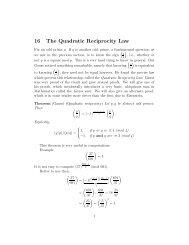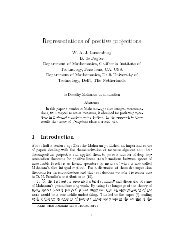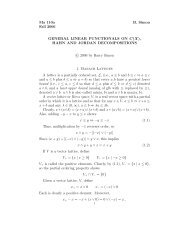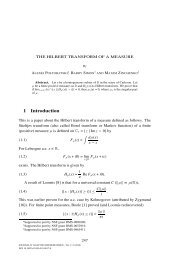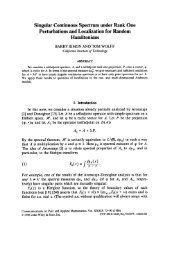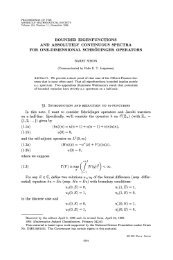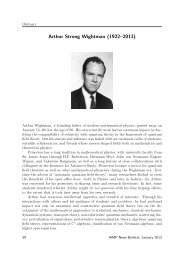Physics Universal Lower Bounds on Eigenvalue Splittings ... - Caltech
Physics Universal Lower Bounds on Eigenvalue Splittings ... - Caltech
Physics Universal Lower Bounds on Eigenvalue Splittings ... - Caltech
Create successful ePaper yourself
Turn your PDF publications into a flip-book with our unique Google optimized e-Paper software.
Communicati<strong>on</strong>s in<br />
Commun. Math. Phys. 97, 453-460 (1985) Mathematical<br />
<str<strong>on</strong>g>Physics</str<strong>on</strong>g><br />
© Springer-Verlag 1985<br />
<str<strong>on</strong>g>Universal</str<strong>on</strong>g> <str<strong>on</strong>g>Lower</str<strong>on</strong>g> <str<strong>on</strong>g>Bounds</str<strong>on</strong>g> <strong>on</strong> <strong>Eigenvalue</strong> <strong>Splittings</strong> for<br />
One Dimensi<strong>on</strong>al Schrodinger Operators<br />
W. Kirsch 1 and B. Sim<strong>on</strong> 2<br />
Divisi<strong>on</strong> of <str<strong>on</strong>g>Physics</str<strong>on</strong>g>, Mathematics and Astr<strong>on</strong>omy, California Institute of Technology, Pasadena, CA<br />
91125, USA<br />
Abstract. We provide lower bounds <strong>on</strong> the eigenvalue splitting for — d 2 /dx 2 +<br />
V(x) depending <strong>on</strong>ly <strong>on</strong> qualitative properties of V. For example, if V is C 00 <strong>on</strong><br />
[α, b~] and £„, £„_ 1 are two successive eigenvalues of — d 2 /dx 2 + V with u(a) =<br />
u(b) = 0 boundary c<strong>on</strong>diti<strong>on</strong>s, and if λ = max \E— V(x)\ 1/2 , then<br />
Ee(E n _ ^EJ xem<br />
The exp<strong>on</strong>ential factor in such bounds are saturated precisely in tunneling<br />
examples. Our results are not restricted to F's of compact support, but <strong>on</strong>ly<br />
require E n < lim V(x).<br />
1. Introducti<strong>on</strong><br />
There are two cases where it is well known that Schrodinger operators have<br />
n<strong>on</strong>-degenerate eigenvalues: The lowest eigenvalue in general dimensi<strong>on</strong> and all<br />
<strong>on</strong>e dimensi<strong>on</strong>al eigenvalues. One can ask about making this quantitative, i.e.<br />
obtain explicit lower bounds <strong>on</strong> the distance to the nearest eigenvalues. Obviously,<br />
<strong>on</strong>e cannot hope to do this without any restricti<strong>on</strong> <strong>on</strong> V 9 since, for example, if χ<br />
is the characteristic functi<strong>on</strong> of (— 1,1), <strong>on</strong>e can show that, for / large, — d 2 /dx 2 —<br />
χ(x) — χ(x — /) has at least two eigenvalues and E ί— £ 0 -• 0 as / -• oo (see e.g. Harrell<br />
[5]). Thus, we ask the following: Can <strong>on</strong>e obtain lower bounds <strong>on</strong> eigenvalues<br />
splittings <strong>on</strong>ly in terms of geometric properties of the set where V(x) < E (E at or<br />
near the eigenvalues in questi<strong>on</strong>) and the size of V <strong>on</strong> this set. We will do precisely<br />
this for the <strong>on</strong>e dimensi<strong>on</strong>al case in this note, and we will prove results <strong>on</strong> the<br />
ground state in multi-dimensi<strong>on</strong>s in [8] (see also W<strong>on</strong>g, Yau and Yau [12]).<br />
While these questi<strong>on</strong>s are of interest for their own value, we came up<strong>on</strong> them<br />
with specific applicati<strong>on</strong>s in mind [7,9].<br />
1 On leave from Institut fur Mathematik, Ruhr Universitat, D-4630 Bochum, West Germany; research<br />
partially supported by Deutsche Forschungsgemeinshaft (DFG)<br />
2 Research partially supported by USNSF under grant MCS-81-20833
454 W. Kirsch and B. Sim<strong>on</strong><br />
Let us state our basic results, (α, fo) will denote an interval c<strong>on</strong>nected with V<br />
which, for simplicity, we take c<strong>on</strong>tinuous. En and En_ί will denote the (n+ l) st<br />
and n ih<br />
eigenvalues of — d 2<br />
/dx 2<br />
+ F, and we define<br />
λ= max \E-V(x)\ 1/2 . (1.1)<br />
£e[£ ll-i,£ B],xe(β,6)<br />
Theorem 1. Lei FeQ? wiίft supp F cz [α, fo]. Lei 0>E n >£ n_! foe eigenvalues of<br />
- d 2<br />
/dx 2<br />
+ F, and feί /I foe #*ι;en by (1.1). Then<br />
Theorem 2. Let V be c<strong>on</strong>tinuous <strong>on</strong> R (but perhaps not bounded above), and suppose<br />
that for a>0, F(x)^£ + a M 2 <strong>on</strong> #\[a,fo], where E >E _ n n 1 are eigenvalues of<br />
-d 2 /dx 2 + V(x). Then<br />
E n - E n . ί ^ πλ 2 oc(λ + a)- l e-W- a \<br />
As a "warm-up," we will prove Theorem 1 under the extra assumpti<strong>on</strong> that<br />
V(x) is even (and a = — fo) in Sect. 2 and the general results in Sect. 3. In Sect. 4,<br />
we give bounds <strong>on</strong> widths of bands in <strong>on</strong>e dimensi<strong>on</strong>al solids. Our proofs in<br />
Sect. 2,3 use the Prϋfer variable Arctan(u'/ — λu).<br />
In order to understand the above bounds, we point out several facts:<br />
(a) The proof <strong>on</strong>ly uses A as a bound, so λ may be replaced by any larger<br />
c<strong>on</strong>stant even if that increases the right side of the bounds, i.e. πλ 2 a(λ + oί)~ 1 e~ λ{b ~ a)<br />
can be replaced by max πμ 2 oc(μ + oc)~ 1 e~ μ{b ~ a) .<br />
(b) There is a scaling covariance here: Making the unitary transformati<strong>on</strong> that<br />
takes x-^μx, and multiplying H by μ 2 takes us to — d 2 /dx 2 + μ 2 V(μx). This<br />
change multiplies λ 2 and E ,E _ by μ n n 1<br />
2 and fo, a by μ~ 1 . One can check that both<br />
sides of the various bounds <strong>on</strong>ly get multiplied by the same factor of μ 2<br />
.<br />
(c) Let χc be the characteristic functi<strong>on</strong> of (— c, c) and let Vc/(x) = —<br />
(χc(x) + χc(x — /))• Then, so l<strong>on</strong>g as c is chosen so large that Eo for £ large is smaller<br />
than —\(this is certainly true since lim lim Eo= — l\ΔE ~ e~ λe ίoτ£ large (see [5]),<br />
so that the factor e~ λ(b ~ a) cannot be replaced by e~ λ(1 +ε H & -«) for any ε > 0. In this<br />
sense, these are precisely tunneling type lower bounds. In fact, the proofs show that, in<br />
a sense we will make precise, the results must be fairly close to tunneling examples to<br />
saturate the exp<strong>on</strong>ential factors in the bounds when (fo — a)λ is large.<br />
(d) From the point of view of tunneling, (fo — a)λ should be replaced by<br />
a<br />
— E) + dx = ί(wherey + =max(y,0)). With our methods, <strong>on</strong>e can probably<br />
replace λ by [(b-a)- 1<br />
$(V(x)-E)dx] 1/2<br />
a<br />
9<br />
which is better than max |F(x)-£| 1/2<br />
but not as good as (fo — a)~ 1<br />
t. By making assumpti<strong>on</strong>s <strong>on</strong> derivatives of F <strong>on</strong>e<br />
might be able to get t out by using an x-dependent scaling factor where we use<br />
the c<strong>on</strong>stant scale factor λ in defining Prϋfer variables. Of course, most detailed<br />
tunneling analyses require some c<strong>on</strong>trol <strong>on</strong> derivatives.
One Dimensi<strong>on</strong>al Schrδdinger Operators 455<br />
(e) Our results are a kind of analog of those of Harrell [6] for res<strong>on</strong>ances.<br />
Da vies [1,2] has emphasized the need for bounds valid in more than an asymptotic<br />
regime.<br />
(f) While we stated the results for (- oo, oo), there are results for finite volume<br />
with various boundary c<strong>on</strong>diti<strong>on</strong>s. See, for example, the end of Sect. 2.<br />
2. Even V of Compact Support: A Warm-Up<br />
Our goal here is to prove Theorem 1 under the additi<strong>on</strong>al assumpti<strong>on</strong> that V is<br />
even in x (so α=-b). We use Prufer variables defined with an extra factor<br />
(following [3]):<br />
where λ is given by (1.1) and u solves<br />
u(x) = r(x)cos(θ(x)% (2.1a)<br />
u'(x)=-λr(x)sin(θ(x)l (2.1b)<br />
- u" + Vu = Eu. (2.2)<br />
θ is <strong>on</strong>ly determined mod2π; we will determine it completely by appropriate<br />
boundary c<strong>on</strong>diti<strong>on</strong>s. From the Ricatti equati<strong>on</strong>: (u'/u)' = (V — E) — {u'ju) 2 , <strong>on</strong>e<br />
immediately obtains<br />
ff(χ) = λ~\E - F(x))cos 2 θ(x) + Asin 2 θ(x). (2.3)<br />
For each E < 0, let u solve (2.2) with the boundary c<strong>on</strong>diti<strong>on</strong> u(x) = Gxp(^/ — Ex)<br />
for xe(— oo,a). Then tanθ(x,E) = — λ~ x ^/ — E <strong>on</strong> (— oo,a) and θ is normalized by<br />
θ(x, E) = - Arctan ly/^E/λ]; - oo c x < a, (2.4)<br />
i.e. by requiring θ(— oo,£)e(— π/2,0). We will see in the next secti<strong>on</strong> (as is<br />
well-known) that for x fixed, θ(x, E) is increasing in E. From (2.3), we see that if<br />
θ= ±π/2, 3π/2,..., then θ'>0 so that <strong>on</strong>e can count up zeros of u by looking<br />
at arg θ. In particular, <strong>on</strong> account of the symmetry<br />
where E n is the (n + l) st eigenvalue.<br />
Define φ(x,E) = dθ/dE(x,E% so by (2.4):<br />
Taking a derivative in (2.3)<br />
β(0,£ M) = mr/2, (2.5)<br />
φ(a,E) = λil^f^E)- \λ 2 -E)~\ (2.6)<br />
φ f = {λ-λ- 1 lE-V(x)^}lsin2θ']φ + λ- 1 cos 2 θ (2.7)<br />
which, by (1.1), has the form when £e[£ n_ l5£J,<br />
From (2.7)<br />
φ\x) = f(x)φ(x) + g(x); \f(x)\ ^ 2λ; \g(x)\ ίλ' 1<br />
. (2.8)
456 W. Kirsch and B. Sim<strong>on</strong><br />
Integrating (recall a < 0)<br />
φ(O)e 2λa<br />
^ φ(a) + \λ~ 2<br />
\\ - e 2λa<br />
] ^ φ(a) + \λ~ 2<br />
(2.9)<br />
(in most cases of interest \λa\ > 1, so we drop the e~ 2]λal<br />
term but it could be retained).<br />
Using (2.6) and the m<strong>on</strong>ot<strong>on</strong>icity of y/\E\(λ 2<br />
φ(0) ^ e* λ<br />
\{2λ 2<br />
)- ι<br />
+ ^λ{J\EA(λ 2<br />
+ |£|) in |£|, we see that<br />
+ \En \} " x<br />
].<br />
If we note that 2\a\ = b — a, the bound in Theorem 1 results if we note that<br />
?- = θ{%E n )-θ{^E n ^)^l max φ(0, £)](£„-£„_!)•<br />
This completes the proof of Theorem 1 in the symmetric case. Note that in<br />
going from (2.8) to (2.9), we could have used Gr<strong>on</strong>walΓs inequality, replacing<br />
JC<br />
2λ(x — a) by J f(y) dy and have improved our result (but make it appear more<br />
complicated; we would adjust λ differently). We could also deal with Dirichlet or<br />
Neumann boundary c<strong>on</strong>diti<strong>on</strong>s <strong>on</strong> an interval. We state the results in general,<br />
although the above proof <strong>on</strong>ly works if V is even (the ideas in the next secti<strong>on</strong><br />
handle the general case). Note that with these fixed boundary c<strong>on</strong>diti<strong>on</strong>s, φ(a) = 0,<br />
so the bound is simpler to state:<br />
Theorem 2.1. Let E n _ l9 E n be two successive eigenvalues of —d 2 /dx 2 + V(x) <strong>on</strong><br />
[α, h] with either Dirichlet or Newman boundary c<strong>on</strong>diti<strong>on</strong>s at both a and b. Let λ<br />
be given by (1.1). Then<br />
3. The General Case<br />
In handling the general case (V may be not of compact support and not necessarily<br />
even) there are two issues which must be addressed in using the idea of the last<br />
secti<strong>on</strong>:<br />
(i) Because V is not even, we cannot be sure that at (a + b/2) θ(x, En) — θ(x, En_ x)<br />
isn't very small.<br />
(ii) We cannot compute θ(a,E) and φ(a,E) = dθ/dE(a,E) exactly and so we<br />
need a separate argument to see that φ(a9 E) isn't too large.<br />
Let us solve (i) first; by doing that, we will have explained how to prove<br />
Theorem 1 and Theorem 2.1 in the n<strong>on</strong>-even case. For this step it is useful to<br />
c<strong>on</strong>sider V{x)=V(a + b-x). Since H=-d 2 /dx 2 + V and -d 2 /dx 2 + V are<br />
unitarily equivalent, they have the same eigenvalues. For E < inf σess(#), let θ(x, £),<br />
8(x, E) denote the Prύfer angle associated to the soluti<strong>on</strong> which is L 2<br />
at — oo via<br />
the transformati<strong>on</strong> (2.1). Because En and En_1 are eigenvalues, we have<br />
S{x 9 E n) = nπ-θ{a + b-x, E n\ (3.1b)<br />
where this relati<strong>on</strong> <strong>on</strong>ly holds for eigenvalues E. The minus sign comes from the
One Dimensi<strong>on</strong>al Schrδdinger Operators 457<br />
flip of sign in u\ and we obtain the factors of π by noting that as x-+ — oo,<br />
θ(x,£ M _ 1 ), 9(x,E n _ 1 )G(— π/2,0) and as x-»oo, 0 must pass through the values<br />
π/2, 3π/2,... exactly n times, each <strong>on</strong>ce. From (3.1), we immediately obtain<br />
Lemma 3.1. One of θ((a + b)/29EJ-Θ({a + b)/29En-1 ) or θ{(a + b)/29E n<br />
)θ((a<br />
- b)/2, En_ x ) is at least π/2.<br />
Proof. By (3.1), the two numbers sum up to π. •<br />
Thus we can make the analysis <strong>on</strong> either V or V 9 and so, without loss, we<br />
can suppose that<br />
/ „ ^L U \ / „ _1_ U \<br />
2 J \ 2<br />
π/2. (3.2)<br />
As for problem (ii), we will use an explicit formula for φ = dθ/dE:<br />
Theorem 3.2. Let E < inf ess sρec(- d 2 /dx 2 + V\<br />
φ(x, E) = λ J u(y) 2 dyl\_λ 2 u(x) 2 + w'(x) 2 ] (3.3)<br />
— oo<br />
vv^βrβ u is the soluti<strong>on</strong> of (2.2) which is / 2 at — oo.<br />
Proof In order to check that u can be chosen to be smooth in E near some E o<br />
(so that θ is C 1 ), we pick W =V near + oo so inf spec (VF) > £ 0 and PF is bounded<br />
below. Let feCξ have support in (- 1,1). Then, <strong>on</strong> (- oo, - 1), we can pick<br />
lf ~\ {x) (3 4)<br />
(u is n<strong>on</strong>-zero since (—d 2 /dx 2 + W — E)' 1 has a strictly positive integral kernel).<br />
From (3.4) and the fact that D(d/dx) a Q(-d 2 /dx 2 + W), we see that u,u f are in<br />
L 2 at — oo. Similarly<br />
du<br />
obeys ύ, ύ'eL 2 at — oo. We note that u is C 1 in E (in L 2<br />
OC in x-sense) because<br />
of the smooth dependence of u(x) <strong>on</strong> u(j) 9 u'( — %). From θ = Arctan(— u'/λu) we<br />
see that<br />
Let<br />
φ = θ = λ(ύu' - uύ')Hλ 2 u 2 + (u') 2 l (3.6)<br />
η(x) = W(X)M'(X) — w(x)zi / (x).<br />
Then, by (2.2) and — ύ" + Vύ = Eύ + u, we see that dη/dx = u 2<br />
. Since η is L 1<br />
at — oo,<br />
we see that<br />
which, given (3.6), proves (3.3).<br />
η(x)= j u 2<br />
u (y)dy<br />
2<br />
(<br />
— 00<br />
-2
458 W. Kirsch and B. Sim<strong>on</strong><br />
Before turning to the proof of Theorem 2, we make two remarks about (3.3).<br />
First of all, it provides the promised proof that φ > 0. Sec<strong>on</strong>dly, the <strong>on</strong>ly way that<br />
φ((a + b)/29E) can be exp<strong>on</strong>entially large for £e[£ n_1? £J, which is required for<br />
our bounds in Theorems 1, 2 to be saturated is if λ 2<br />
u(x) 2<br />
+ u'{x) 2<br />
is exp<strong>on</strong>entially<br />
small. This is precisely typical of tunneling situati<strong>on</strong>s, that these M'S which are<br />
small at — oo are also small in the center of the regi<strong>on</strong> (α, b) of importance.<br />
We can now solve problem (ii) by using:<br />
Lemma 3.3. Let<br />
V(x) ^E + oc 2 (3.7)<br />
<strong>on</strong> ( — oo, α], and let u solve (2.2) and be L 2 and positive at — oo. Then for xe( — oo, α]:<br />
u(x)^e« (χ - a) u(a). (3.8)<br />
Proof. We will show that e~ ax u(x) is m<strong>on</strong>ot<strong>on</strong>e increasing <strong>on</strong> (— oo,α]. Since<br />
(e-"*u(x))' = e~ ax (u f - au) = λe-* x r(x)(- sinθ(x) - J~z cos θ(x))<br />
(where s = oc 2 /λ 2 ) and θ(x)e(— π,0) <strong>on</strong> (— oo,α), it suffices that<br />
(x) (3.9)<br />
<strong>on</strong> (- oo, a).<br />
Note first that since V — E>0 <strong>on</strong> (— oo,α), u and u' are both positive there<br />
by a standard ODE argument. Thus, <strong>on</strong> (— oo,α), θ(x) < 0.<br />
By (2.3) and (3.7)<br />
θ\x) < >l(sin 2 θ - s cos 2 θ). (3.10)<br />
Pick ε r < ε. We will show that (3.9) holds with ε replaced by ε' and then make a<br />
limiting argument. Let θ o = -Arctan^/ε 7 . By (3.10), θ'(x)^c θ 0 for some xe(— oo, α), this inequality implies that θ(y) = 0 for some<br />
ye(x — 0 o/2,x) which is impossible by the above remarks. Thus, (3.9) holds. •<br />
Proof of Theorem 2. By (3.3) and (3.8)<br />
φ{a)^λ J e 2 ^ x - a) u{a /<br />
— CO<br />
By (2.7) and the argument following it<br />
But, by (3.2),<br />
sup<br />
Ee[E n _ v E n ]<br />
which yields the bound of Thm. 2.
One Dimensi<strong>on</strong>al Schrόdinger Operators 459<br />
4. Widths of Bands in One-Dimensi<strong>on</strong>al Solids<br />
Another situati<strong>on</strong> where n<strong>on</strong>-zero objects can be exp<strong>on</strong>entially small due to<br />
tunneling is the case of band widths in <strong>on</strong>e dimensi<strong>on</strong>al periodic potentials [4,11].<br />
Here, we want to note an elementary lower bound <strong>on</strong> such widths. It is related<br />
to what has g<strong>on</strong>e earlier in two interlocking ways: (i) One could think of the<br />
argument in Sect. 2 as comparing operators <strong>on</strong> (— oo,0] with Dirichlet and<br />
Newmann boundary c<strong>on</strong>diti<strong>on</strong>s; band widths compare a periodic and antiperiodic<br />
eigenvalue, (ii) We will use the discriminant which is intimately related to θ.<br />
Theorem 4.1. Let [£ b ,£J be a band of the spectrum of —d 2<br />
/dx 2<br />
+ V(x) 9 where<br />
V(χ + L) = V(x). Let Em = max(|£ b |, \Et \). Then<br />
£ ί-£ &^2exp[-(ypΪL+ v^J + l)L]. (4.1)<br />
Remark. The tunneling results of [4,11] show this is optimal in the sense that L<br />
cannot be replaced by (1 + ε)L.<br />
Proof Let Δ(E) be the discriminant. Then [10]<br />
\Δ(E)\ £2exp(Lj\E\)cosh(Lj\\V\U. (4.2)<br />
([10] proves this for L = π; the general case follows by scaling.) Since Δ(E) is<br />
analytic and (4.2) holds for all complex £, a Cauchy estimate using the circle<br />
E - E\ = 1 shows that<br />
\Δ'(£)| S 2expl(^WL + y/\E\ + 1)]. (4.3)<br />
Since, by the theory of the discriminant [10]: \Δ(E t )—Δ(E b )\ = 4, and (4.3) implies<br />
(4.1). •<br />
Acknowledgement. W. Kirsch would like to thank E. St<strong>on</strong>e and W. Luxemburg for the hospitality of<br />
<strong>Caltech</strong>, where this work was d<strong>on</strong>e.<br />
References<br />
1. Davies, E. B.: JWKB and related bounds <strong>on</strong> Schrδdinger eigenfuncti<strong>on</strong>s. Bull. L<strong>on</strong>d<strong>on</strong> Math. Soc. 14,<br />
273-284 (1982)<br />
2. Davies, E. B.: Structural isomers, double wells, res<strong>on</strong>ances and Dirichlet decoupling. Univ. of<br />
L<strong>on</strong>d<strong>on</strong> Preprint<br />
3. Deift, P., Sim<strong>on</strong>, B.: Almost periodic Schrόdinger operators, III. The absolutely c<strong>on</strong>tinuous spectrum<br />
in <strong>on</strong>e dimensi<strong>on</strong>. Commun. Math. Phys. 90, 389-411 (1983)<br />
4. Harrell, E.: The band structure of a <strong>on</strong>e dimensi<strong>on</strong>al periodic system in a scaling limit. Ann. Phys. 119,<br />
351-369 (1979)<br />
5. Harrell, E.: Double wells. Commun. Math. Phys. 75, 239-261 (1980)<br />
6. Harrell, E.: General lower bounds for res<strong>on</strong>ances in <strong>on</strong>e dimensi<strong>on</strong>. Commun. Math. Phys. 86,<br />
221-225 (1982)<br />
7. Kirsch, W., Kotani, S., Sim<strong>on</strong>, B.: Absence of absolutely c<strong>on</strong>tinuous spectrum for some <strong>on</strong>e<br />
dimensi<strong>on</strong>al random but deterministic Schrόdinger operators. Ann. Inst. H. Poincare (submitted)<br />
8. Kirsch, W., Sim<strong>on</strong>, B.: Comparis<strong>on</strong> theorems <strong>on</strong> the gap for Schrόdinger operators. J. Funct. Anal<br />
(submitted)<br />
9. Kirsch, W., Sim<strong>on</strong>, B.: Lifschitz tails for periodic plus random potentials. J. Stat. Phys. (submitted)
460 W. Kirsch and B. Sim<strong>on</strong><br />
10. Magnus, W., Winkler, S.: Hill's equati<strong>on</strong>, New York: Interscience, 1966, Dover editi<strong>on</strong> available<br />
11. Sim<strong>on</strong>, B.: Semiclassical analysis of low lying eigenvalues, III. Width of the ground state band in<br />
str<strong>on</strong>gly coupled solids. Ann. Phys. (to appear)<br />
12. W<strong>on</strong>g, B., Yau, S. S. T., Yau, S. -T.: An estimate of the gap of the first two eigenvalues in the<br />
Schrόdinger operator. Preprint<br />
Communicated by T. Spencer<br />
Received June 11, 1984; in revised form August 10, 1984


